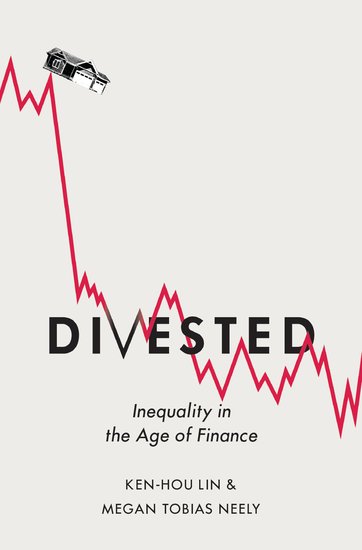Richard Godden: “Divested: Inequality in the Age of Finance”, by Ken-Hou Lin and Megan Tobias Neely

Ken-Hou Lin is an Associate Professor of Sociology at the University of Texas at Austin and Megan Tobias Neely is a Post-Doctoral Researcher at Stanford University, studying gender, race and social class inequality. They are alarmed by the growth of inequality in the United States of America over the past generation and blame this on the “financialisaton” of the US economy, which they define as “The wide-ranging reversal of the role of finance from a secondary, supportive activity to a principal driver of the economy” (page 10, italics original). They assert that “To understand contemporary finance is to understand contemporary inequality” (page 2) and that previous studies often touch only on fragments of the connection between finance and inequality. Hence, they set out to “provide a more comprehensive synthetic account of how financialisaton has led to greater inequality in the United States” (page 4).
The analysis which follows includes a whistle stop review of the world economic system since the Second World War and a closer examination of many trends over recent decades. Building on the work of others, they bring together copious statistics, particularly in the form of dozens of graphs indicating economic trends. Absorbing the statistics and considering their implications takes time, so this is not a book to be read fast. However it is not a heavy read and does not require a great amount of prior knowledge.
Lin and Neely make a number of interesting observations that deserve careful consideration. These relate to subjects as diverse as the implications of outsourcing, the reluctance of employers to provide on the job training and the risk implications of the modern dislike of investment managers for conglomerates. There is thus much in the book that is worthy of consideration.
Unfortunately, however, the analysis that the authors provide, which purports to bring the wealth of statistical information together, is most unsatisfactory. In particular, the analysis of causation is poor and unpersuasive even in relation to the core thesis of the book. Although Lin and Neely acknowledge the role of globalisation and the growth of IT in increasing inequality (at one point saying that former “is a broadly convincing explanation of rising inequality”, page 38), they dismiss these things as primary factors, regarding them as essentially background circumstances against which other things have resulted in growing inequality. Yet there is no satisfactory analysis to back up this position and their blaming of many US specific factors is somewhat undermined by their frank admission towards the end of the book that “similar trends have unfolded in Europe, Asia, and other countries” (page 181).
The book contains many statements designed to demonstrate that the authors recognise fundamental economic realities and do not wish to deal in caricatures: early in the book, they recognise that finance is indispensable for a prosperous society and dismiss populist claims that financial professionals are evil; they acknowledge that deregulation could be beneficial (citing evidence that suggests that relaxing the US intrastate bank branch restrictions in the 1980s was associated with local economic growth); they draw attention to the problems with Keynesian economics that emerged in the 1960s and 1970s; and they accept the value of many financial products, including derivatives. However, these promising statements are outnumbered by less balanced comments and, at times, careful analysis is replaced by extreme assertions, such as the statement that the profitability of financial ventures “depends on the harm they bring” (page 60, emphasis original) and that finance “has morphed into a snake ruthlessly devouring its own tail” (page 83).
On a number of occasions, the authors come close to Luddism. The statement that the Industrial Revolution “created … massive poverty” (page 29) is extraordinary but irrelevant to the argument of the book. However, other statements are less easily ignored. For example, it is clearly arguable that some of the cost cutting and other actions taken by the management of numerous companies over the past generation has been unduly influenced by short-termism (particularly short-term stock market considerations) and on occasion has been carried out in a way that many would consider reprehensible. If Lin and Neely had confined their comments regarding cost cutting to this then there would have been little to object to in what they say about it. However, they do not: they lump together all cost saving measures and thus fail to recognise the long-term economic benefits of continually increasing efficiency. Thus they comment adversely on those managers who had “a deep conviction that a firm’s performance could be optimised with sophisticated cost-benefit analysis” and that parts of companies should “be evaluated, eliminated, or expanded according to their profitability” (page 87). They also lament the fact that “new technologies have been adopted to replace unionised work forces” (page 110) and the fact that “To maximise returns for shareholders, firms have cut costs by automating and downsizing jobs, moving factories oversees, outsourcing entire production units, and channelling resources into financial ventures” (page 118).
Although in places, the authors acknowledge that things were not perfect in the past and they warn about romanticising it, there is a definite note of nostalgia in the book. On several occasions, they contrast current management attitudes unfavourably with what they perceive to be the objective of US industrialists in past years, namely “to broaden their market share – the prior gold standard for corporate management” (page 180). They also talk fondly of the historic “capital-labor accord” (e.g. page 45) and suggest that there was once “a fair-wage model” that sustained long-term employment relationships (page 47), seemingly blind to the confrontations that dogged industrial relations in the USA and elsewhere through much of the twentieth century. One wonders whether, deep down, they are nostalgic for the days of US economic hegemony and the prosperity that it bought in the generation following the Second World War.
Whatever the deficiencies in the book’s analysis one would have expected it to contain clear policy suggestions but it does not. Lin and Neely urge us to “scrutinise the rules of the game” (page 177) and call for “inventive and carefully considered policies” (page 184) but what follows is little more than a series of vague general comments and micro proposals. It is hard to understand what the authors are advocating. For example, in the introduction, they indicate that they believe that policies targeting high-earners, such as earnings caps and progressive taxes, are necessary but they never explain what kind of earnings caps they have in mind and, in their conclusion, appear to suggest that increasing tax may not be practicable or even the best approach. Likewise, having suggested on various occasions that the repeal of the Glass-Steagall Act (the US Banking Act of 1933) has caused many problems, the authors declare that “The Glass-Steagall era has passed and its restrictions are no longer sensible a century later” (page 184).
The book concludes in an anti-climax: “We suspect that there are many answers to the social question through which economic institutions could be organised and conducted so that all members of society more justly share their benefits. These answers must be imagined” (sic, page 190). Indeed they must, because there is little in the book to tell us what they might be.
“Divested: Inequality in the Age of Finance”, by Ken-Hou Lin and Megan Tobias Neely, was published in 2020 by Oxford University Press (ISBN 978-0-19-0638313). 190pp.
 Richard Godden is a Lawyer and has been a Partner with Linklaters for over 25 years during which time he has advised on a wide range of transactions and issues in various parts of the world.
Richard Godden is a Lawyer and has been a Partner with Linklaters for over 25 years during which time he has advised on a wide range of transactions and issues in various parts of the world.
Richard’s experience includes his time as Secretary at the UK Takeover Panel and a secondment to Linklaters’ Hong Kong office. He also served as Global Head of Client Sectors, responsible for Linklaters’ industry sector groups, and was a member of the Global Executive Committee.
